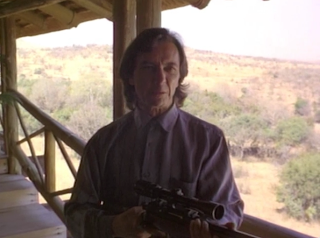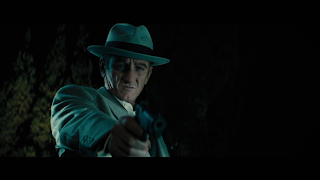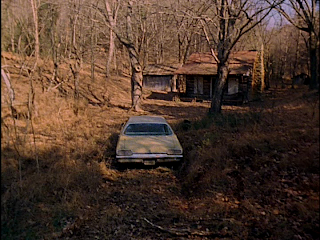We watch several movies a week. Every Friday, we'll talk a little about some of the movies we watched that we felt were Worth Mentioning.
Cody viewed early Van Damme, unpopular Stallone, and some more Mark L. Lester.
The real Dux retired from the Kumite undefeated. The movie tells the story of his first tournament, which he goes A.W.O.L. from the Army to compete in. Flashbacks to the training in Ninjitsu he received from Japanese master Senzo Tanaka over his formative years explains why the Kumite is so important to him: Tanaka had been training his own son to someday compete in the tournament, but after the boy dies at a young age Dux takes it upon himself to honor Tanaka at the Kumite. A noble idea, but it doesn't keep Army detectives (one of whom is Forest Whitaker) from attempting to track him down in Hong Kong, where the Kumite is being held.
EYE SEE YOU (2002)
Sylvester Stallone had his closest brush with the horror genre since 1986's Cobra in this murder mystery from I Know What You Did Last Summer director Jim Gillespie.
Stallone stars as FBI agent Jake Malloy, on the trail of a serial killer of police officers who leaves the mutilated corpses of his victims strung up in grotesque displays to torment the other officers who have to deal with the crime scene. When the killer targets Malloy and orchestrates an event that is hugely traumatizing for him, the investigator's life goes spiralling out of control.
After a suicide attempt, Malloy ends up at a newly opened detox center, run by cops for cops and set up at a remote location in the Wyoming countryside. Once Malloy is at the center, it's Ten Little Indians time. The killer has followed him. The phone line is severed, a blizzard hits, the heat goes out, the doctors and patients are trapped and the killer starts whittling down the supporting cast, which includes such notable names as Charles S. Dutton, Kris Kristofferson, Jeffrey Wright, Tom Berenger, Stephen Lang, Robert Patrick, Polly Walker, Dina Meyer, Robert Prosky, Rance Howard, Sean Patrick Flanery, and Courtney B. Vance, one-by-one.
This movie gets a bum rap. Its rankings are in the toilet, the studio that funded it was so disappointed with it that they shelved it for three years before it finally escaped pretty much direct-to-video. It's not nearly bad enough to deserve that kind of treatment. It's not one of Stallone's greats, it's not on the level of the movies it brings to mind along the way like Seven, The Shining, or John Carpenter's The Thing, but I think it's a pretty decent little thriller in its own right.
The original title was D-Tox and the story is based on a novel by Howard Swindle called Jitter Joint, but while the movie was gathering dust on the shelf someone in marketing decided that the goofy Eye See You was the title to go with in the U.S. Funny though it is, it does make sense for the movie - "I see you"/"ICU" is a repeated taunt from the killer, who has an obsession with eyes and a proclivity for damaging them.
Cody viewed early Van Damme, unpopular Stallone, and some more Mark L. Lester.
BLOODSPORT (1988)
Jean-Claude Van Damme, the good ol' Muscles from Brussels, got his first starring role in this film, which is based on the experiences of Frank Dux, an American martial arts master. Between 1975 and 1980, Dux is said to have fought 329 matches in underground Kumite tournaments, brutal fights that can result in serious injury or death.
The real Dux retired from the Kumite undefeated. The movie tells the story of his first tournament, which he goes A.W.O.L. from the Army to compete in. Flashbacks to the training in Ninjitsu he received from Japanese master Senzo Tanaka over his formative years explains why the Kumite is so important to him: Tanaka had been training his own son to someday compete in the tournament, but after the boy dies at a young age Dux takes it upon himself to honor Tanaka at the Kumite. A noble idea, but it doesn't keep Army detectives (one of whom is Forest Whitaker) from attempting to track him down in Hong Kong, where the Kumite is being held.
Dux proves to be a very impressive fighter, breaking records as he climbs the ranks, drawing the attention of the reigning champion, the undefeated Chong Li, a fighter who too often crosses the line and causes unnecessary harm to his opponents. He even killed a man at the previous tournament and showed no remorse for it. As Chong Li is the legendary Bolo Yeung, the nose-clearing 5'6" mountain of muscle who made many a martial arts/action movie in his day and always made an impression on the viewer.
Between bouts, Dux romances an attractive female reporter who's out to learn the secrets of the Kumite and befriends fellow fighter Ray Jackson, played by the awesome Donald Gibb, who's best known as Ogre from the Revenge of the Nerds series.
Tournament matches between fighters with a wide variety of styles make up the better part of an hour in the 92 minute film, making Bloodsport an easy movie to watch and quite enjoyable if you're in the mood for this sort of thing.
My brother was certainly into it back at the end of the '80s and into the early '90s, Bloodsport was recorded onto a VHS during one its airings on HBO or Cinemax and that video got a lot of play. This and the similar JCVD vehicle Kickboxer were my brother's go-to movies for quite a while.
Bloodsport's success, making $11 million theatrically on a $1 million budget, really got Van Damme's career rolling, and looking at the marketing materials makes me long for the simpler days when a moment like a muscular Belgian delivering a jump kick to the chest of Bolo Yeung could be a movie's biggest selling point, being both the last shot in the trailer and the image on the theatrical poster.
Bloodsport's success, making $11 million theatrically on a $1 million budget, really got Van Damme's career rolling, and looking at the marketing materials makes me long for the simpler days when a moment like a muscular Belgian delivering a jump kick to the chest of Bolo Yeung could be a movie's biggest selling point, being both the last shot in the trailer and the image on the theatrical poster.
NIGHT OF THE RUNNING MAN (1995)
Las Vegas cabbie Jerry Logan (Andrew McCarthy) ends up with a million dollars of mob money in his possession thanks to an ill-fated fare who gets murdered right in front of his eyes. To eliminate the taxi driving witness and retrieve the cash, the mob sends hitman David Eckhart (Scott Glenn) after him. Jerry goes on the run, Eckhart hot on his trail and willing to take any ruthless action necessary to stay on it.
Eckhart is a great role for Glenn; a calm, relentless badass totally bereft of any good qualities as a human being. John Glover has some memorable moments as a cohort of Eckhart's who is his own type of laidback evil. The lovely Janet Gunn gets involved with Jerry along the way as an inordinately helpful nurse, providing the film with the required love interest. Appropriately, given the Vegas setting, Wayne Newton has a couple scene cameo.
A very quick and simple crime story, Night of the Running Man is another example of director Mark L. Lester (Commando, Showdown in Little Tokyo, Class of 1999) delivering some straightforward entertainment.
Las Vegas cabbie Jerry Logan (Andrew McCarthy) ends up with a million dollars of mob money in his possession thanks to an ill-fated fare who gets murdered right in front of his eyes. To eliminate the taxi driving witness and retrieve the cash, the mob sends hitman David Eckhart (Scott Glenn) after him. Jerry goes on the run, Eckhart hot on his trail and willing to take any ruthless action necessary to stay on it.
Eckhart is a great role for Glenn; a calm, relentless badass totally bereft of any good qualities as a human being. John Glover has some memorable moments as a cohort of Eckhart's who is his own type of laidback evil. The lovely Janet Gunn gets involved with Jerry along the way as an inordinately helpful nurse, providing the film with the required love interest. Appropriately, given the Vegas setting, Wayne Newton has a couple scene cameo.
A very quick and simple crime story, Night of the Running Man is another example of director Mark L. Lester (Commando, Showdown in Little Tokyo, Class of 1999) delivering some straightforward entertainment.
EYE SEE YOU (2002)
Sylvester Stallone had his closest brush with the horror genre since 1986's Cobra in this murder mystery from I Know What You Did Last Summer director Jim Gillespie.
Stallone stars as FBI agent Jake Malloy, on the trail of a serial killer of police officers who leaves the mutilated corpses of his victims strung up in grotesque displays to torment the other officers who have to deal with the crime scene. When the killer targets Malloy and orchestrates an event that is hugely traumatizing for him, the investigator's life goes spiralling out of control.
After a suicide attempt, Malloy ends up at a newly opened detox center, run by cops for cops and set up at a remote location in the Wyoming countryside. Once Malloy is at the center, it's Ten Little Indians time. The killer has followed him. The phone line is severed, a blizzard hits, the heat goes out, the doctors and patients are trapped and the killer starts whittling down the supporting cast, which includes such notable names as Charles S. Dutton, Kris Kristofferson, Jeffrey Wright, Tom Berenger, Stephen Lang, Robert Patrick, Polly Walker, Dina Meyer, Robert Prosky, Rance Howard, Sean Patrick Flanery, and Courtney B. Vance, one-by-one.
This movie gets a bum rap. Its rankings are in the toilet, the studio that funded it was so disappointed with it that they shelved it for three years before it finally escaped pretty much direct-to-video. It's not nearly bad enough to deserve that kind of treatment. It's not one of Stallone's greats, it's not on the level of the movies it brings to mind along the way like Seven, The Shining, or John Carpenter's The Thing, but I think it's a pretty decent little thriller in its own right.
The original title was D-Tox and the story is based on a novel by Howard Swindle called Jitter Joint, but while the movie was gathering dust on the shelf someone in marketing decided that the goofy Eye See You was the title to go with in the U.S. Funny though it is, it does make sense for the movie - "I see you"/"ICU" is a repeated taunt from the killer, who has an obsession with eyes and a proclivity for damaging them.




































































































































































